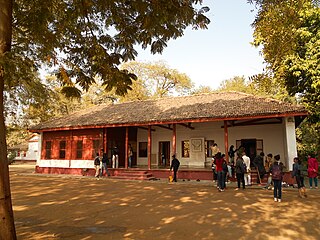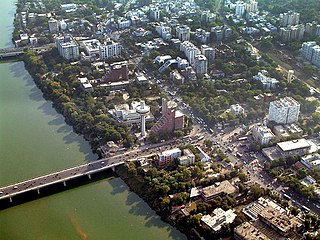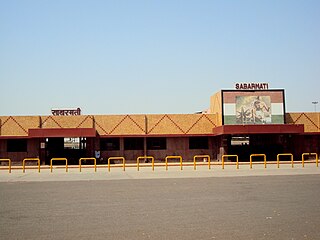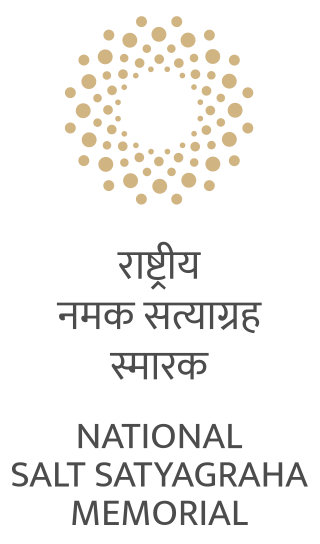
Ahmedabad, also spelled as Amdavad, is the most populous city in the Indian state of Gujarat. It is the administrative headquarters of the Ahmedabad district and the seat of the Gujarat High Court. Ahmedabad's population of 5,570,585 makes it the fifth-most populous city in India, and the encompassing urban agglomeration population estimated at 6,357,693 is the seventh-most populous in India. Ahmedabad's 2024 population is now estimated at 8,854,444. Ahmedabad is located near the banks of the Sabarmati River, 25 km (16 mi) from the capital of Gujarat, Gandhinagar, also known as its twin city.

The Salt march, also known as the Salt Satyagraha, Dandi March, and the Dandi Satyagraha, was an act of nonviolent civil disobedience in colonial India, led by Mahatma Gandhi. The 24-day march lasted from 12 March 1930 to 6 April 1930 as a direct action campaign of tax resistance and nonviolent protest against the British salt monopoly. Another reason for this march was that the Civil Disobedience Movement needed a strong inauguration that would inspire more people to follow Gandhi's example. Gandhi started this march with 78 of his trusted volunteers. The march spanned 387 kilometres (240 mi), from Sabarmati Ashram to Dandi, which was called Navsari at that time. Growing numbers of Indians joined them along the way. When Gandhi broke the British Raj salt laws at 8:30 am on 6 April 1930, it sparked large-scale acts of civil disobedience against the salt laws by millions of Indians.
This page provides a historical timeline of Ahmedabad, the sixth largest city in India.

Sabarmati Ashram is located in the Sabarmati suburb of Ahmedabad, Gujarat, adjoining the Ashram Road, on the banks of the River Sabarmati, 4 miles (6.4 km) from the town hall. This was one of the many residences of Mahatma Gandhi who lived at Sabarmati (Gujarat) and Sevagram when he was not travelling across India or in prison. He lived in Sabarmati or Wardha for a total of twelve years with his wife Kasturba Gandhi and followers, including Vinoba Bhave. The Bhagavad Gita was recited here daily as part of the Ashram schedule.

Kaba Gandhi No Delo is a house and a museum in Rajkot, Gujarat, India. It was Indian independence leader Mahatma Gandhi's primary family home from 1881 to 1915. It is built in the traditional Saurashtrian architectural style and houses a permanent pictorial exhibition called Gandhi Smriti.

Ravishankar Vyas, better known as Ravishankar Maharaj, was an Indian independence activist, social worker and Gandhian from Gujarat.
Navsari is the ninth biggest city in the state of Gujarat in India. It is the administrative headquarters of Navsari District. Navsari is between Surat and Mumbai. It is a twin city of Surat, 37 km to the north. At the 2011 Census of India, Navsari was the 16th biggest city of Gujarat state. It ranked 10th most populous city of Gujarat in the 1991 Census of India and 2001 Census of India. Dandi village near Navsari was the focal point of the great Salt March led by Mahatma Gandhi during civil disobedience movement of India.

Dharasana Satyagraha was a protest against the British salt tax in colonial India in May 1930. Following the conclusion of the Salt March to Dandi, Mahatma Gandhi chose a non-violent raid of the Dharasana Salt Works in Gujarat as the next protest against British rule. Hundreds of satyagrahis were beaten by soldiers under British command at Dharasana. The ensuing publicity attracted world attention to the Indian independence movement and brought into question the legitimacy of British rule in India. The legitimacy of the Raj was never re-established for the majority of Indians and an ever increasing number of British subjects. Along with international attention, the Indian Independence Movement continued to spring into widespread support among the Indian population, with general disdain of the colonial government due to the violent antics of British officials at Dharasana.

Kochrab Ashram, also known as Satyagraha Ashram, is a historic site and museum in Ahmedabad, Gujarat, India. The ashram was the founded in May 1915 by Mahatma Gandhi, leader of the Indian independence movement. For the next two years he lived in the ashram with several other members of the movement. Some of his Gandhian ideas were conceived during that time. In 1953 the Bombay State named the ashram a memorial and tendered it to the Gujarat Vidyapith a year later. Its renovation and redevelopment into a museum were completed in 2024.

Ahmedabad is located on the banks of the River Sabarmati in the northern part of Gujarat and the western part of India. It is located at 23.03°N 72.58°E spanning an area of 550 km2. The average elevation is 53 metres.

Manibhai Bhimbhai Desai was an Indian social activist, associate of Mahatma Gandhi, and a pioneer of rural development.

J. C. Kumarappa was an Indian economist and a close associate of Mahatma Gandhi. A pioneer of rural economic development theories, Kumarappa is credited for developing economic theories based on Gandhism – a school of economic thought he coined "Gandhian economics."
Taxation of salt has occurred in India since the earliest times. However, this tax was greatly increased when the British East India Company began to establish its rule over provinces in India. In 1835, special taxes were imposed on Indian salt to facilitate its import. This paid huge dividends for the traders of the British East India Company. When the Crown took over the administration of India from the Company in 1858, the taxes were not revoked.

South Gujarat, also known as Dakshin Gujarat, is a region in the Indian state of Gujarat. The region has a wetter climate than other regions of Gujarat. The western part is almost coastal and is known as Kantha Vistar, and the eastern part is also known as Dungar Vistar, which ranges from 100 to 1000 metres, with the highest peak at Saputara in the Dang district.

Sabarmati Junction railway station is a junction station of the Indian Western Railway in Ahmedabad, Gujarat. The station is six kilometres (3.7 mi) from the main Ahmedabad Junction railway station on the Ahmedabad–Delhi main line, at Dharamnagar near the Sabarmati Ashram. Sabarmati Junction has 2 tracks, the Mehsana line, and the Botad line, in addition to the main broad-gauge line for trains departing from Ahmedabad. The station has a dedicated rail yard for passenger trains, and was proposed in 2010 for development as an additional terminal for Delhi-bound trains.

Mahatma Mandir is a convention and exhibition centre located at sector 13 C in Gandhinagar, Gujarat, India. It is inspired by the life and philosophy of Mahatma Gandhi. It is one of the biggest convention centres in India, spread over an area of 34 acres. It was developed by the Government of Gujarat. Business summits like Vibrant Gujarat Global Investor Summit 2011, 2013, 2015, 2017 and 2019 were organised here.

Dandi Beach is one of the prominent beaches located in Dandi village, Gujarat, India. Dandi beach is one of the cleanest beaches in the Arabian Sea. Dandi Beach is historically prominent as Mahatma Gandhi led the salt sathyagraha from Sabarmati Ashram (Ahmedabad) to Dandi. This is the beach where Mahatma Gandhi broke the salt tax law of the British after the Salt March.

Mithuben Hormusji Petit was one of the pioneer Indian independence female activists who participated in Mahatma Gandhi's Dandi March. She became a recipient of India’s fourth highest-civilian honour, Padma Shri in 1961, for her social work.

The National Salt Satyagraha Memorial or Dandi Memorial is a memorial in Dandi, Gujarat, India, that honors the activists and participants of the Salt Satyagraha, an act of nonviolent civil disobedience in colonial India which was led by Mahatma Gandhi in 1930. The memorial is spread over a 15 acres (61,000 m2) and is located in the coastal town of Dandi, where the Salt March ended on 5 April 1930 and the British salt monopoly was broken by producing salt by boiling sea water. The project was developed at an estimated cost of ₹89 crore (US$11 million).
Gandhi Smriti railway station is a small railway station on the Western Railway network in the state of Gujarat, India. Gandhi Smriti railway station is 3 km away from Navsari railway station. Passenger and MEMU trains halt here.


















